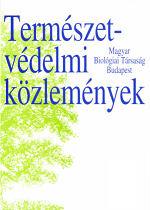Effects of grazing intensity on the biological diversity of grasslands of the Hungarian Great Plain
Abstract
Farmland covers half of Europe, and two-third of Hungary. Therefore, the understanding of the relationship of management and biodiversity is a priority research in conservation biology. We compared extensively and intensively grazed pastures within the EASY EU 5 FP project, based on 348 plant-, 46 bird-, 806 arthropod species, and on landscape ecological measures. Sample areas were in the Kiskunság (alkali and wet meadow areas) and in the Heves (alkali grasslands). Sampling was carried out in 2003. There is no management effect on the number of species, in either of the taxa, and in four out of the ten in abundance. The three sample regions, however, separated clearly. The management by region interaction term is significant for eight taxa out of ten. It indicates that management has effect on grassland assemblages, but this effect varies across regions.
References
Ángyán, J., Tardy, J. & Vajnáné-Madarassy, A. (szerk.) (2003): Védett és érzékeny természeti területek mezőgazdálkodásának alapjai. - Mezőgazda, Budapest.
Báldi, A. (2005): Az agrár-környezetvédelmi programok ökológiai kutatásának szükségességéről. - A Falu, 20: 61-65.
Báldi, A., Batáry, P. & Erdős, S. (2005): Effects of grazing intensity on bird assemblages and populations of Hungarian grasslands. - Agriculture, Ecosystems & Environment, 108: 251-263.
Báldi, A., Batáry, P, Erdős, S. & Sárospataki, M. (2006): A biológiai sokféleség megőrzésének lehetőségei az agrár-környezetvédelemben. - Magyar Tudomány, 2006/6: 670-674.
Báldi, A., Batáry, P, Kleijn, D., Erdős, S., Kisbenedek, T., Őrei, K. M., Orosz, A., Podlussány, A., Rédei, D., Rédei, T., Rozner, I. Sárospataki, M., Szél, G. & Szűts, T. Effect of grazing intensity on biodiversity in semi-natural grasslands in Hungary: lessons for new agri-environment schemes. Submitted.
Batáry, P, Őrei, K.M., Báldi, A., Kleijn, D., Kisbenedek, T. & Erdős, S. (2007). Effects of local and landscape scale and cattle grazing intensity on Orthoptera assemblages of the Hungarian Great Plain. - Basic and Applied Ecology, 8: 280-290.
Demeter, A. (szerk.) (2002): Magyarország és a Natura 2000. Európai hálózat a természeti értékek megőrzésére. - Öko Rt., Budapest.
Dieterich, M. & Van der Straaten, J. (eds.) (2004): Cultural landscapes and land use - The nature conservation-society interface. - Kluwer Academic Publisher, Dordrecht.
Duelli, R, Obrist, M. K. & Schmatz, D. R. (1999): Biodiversity evaluation in agricultural landscapes: above-ground insects. - Agriculture, Ecosystems & Environment, 74: 33-64.
Gregory, R. D., Strien, A. van, Vorisek, R, Gmelig Meyling, A. W., Noble, D. G., Foppen, R. P. B. & Gibbons, D. W. (2005): Developing indicators for European birds. - Philosophical Transactions o f the Royal Society B: Biological Sciences, 360: 269-288.
Kovács, A., Batáry, P. & Báldi, A. (2007): A tájszerkezet hatása őszi vetésű gabonaföldek flórájára és íteltlábú faunájára. Tájökológiai Lapok, 5: 151-160.
Kleijn, D. & Sutherland, W. J. (2003): How effective are European agri-environment schemes in conserving and promoting biodiversity? - Journal o f Applied Ecology, 40: 947-969.
Mattison, E. H. A. & Norris, K. (2005): Bridging the gaps between agricultural policy, landuse and biodiversity. - Trends in Ecology and Evolution, 20: 610—616.
SPSS, (1999): SPSS Base 10.0. - SPSS Inc., Chicago, USA.
Szép, T., Halmos, G. & Nagy, K. (2006): Madarak monitoringja - a természeti állapotot befolyásoló regionális, országos és globális hatások monitorozása. - Magyar Tudomány, 2006/6: 675-679.
Tóth, Z. & Báldi, A. (2006): Az organikus gazdálkodás hatása a biodiverzitásra. - Természetvédelmi Közlemények, 12: 17-33.
Varga, Z. (1995): Geographical patterns of biological diversity in the Palaearctic Region and the Carpathian Basin. — Acta Zoologica Academiae Scientiarum Hungaricae, 41: 71-92.
Verhulst, J., Báldi, A. & Kleijn, D. (2004): The relation between land-use intensity and species- richness and abundance of birds in Hungary. - Agriculture, Ecosystems & Environment, 104: 465-473






